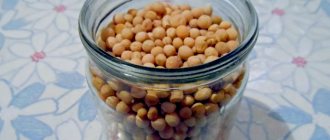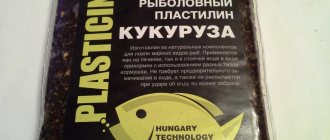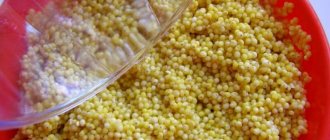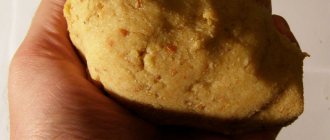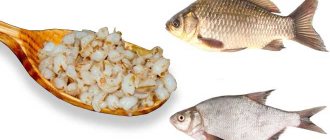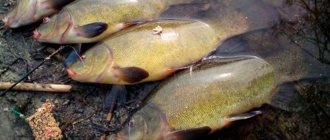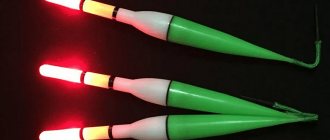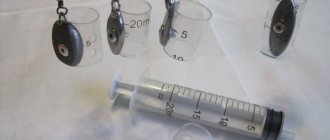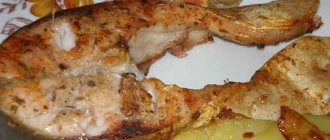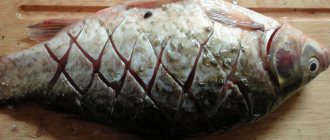Fishing is considered one of the most favorite pastimes of most men.
At the same time, each of them prefers to use their favorite tackle, bait and bait. Basically, fishermen use bait of both animal and plant origin. Which bait and when to catch certain types of fish is a rhetorical question. Each fisherman has his own answer to this. Despite this, most experienced fishermen have long preferred ordinary peas, but for this, they need to be properly cooked.
Using peas for fishing
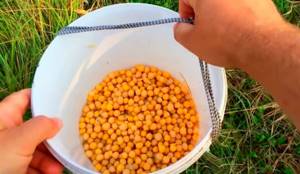
Anglers have been using peas to catch fish since the days of fishing. At the same time, peas are used for fishing both in still water and in the current. Peas have a distinct aroma, which attracts fish. Fishing will be most effective when the fish have been fed in advance.
Each fisherman has his own favorite and effective recipe, which he has tried on a specific body of water.
Subtleties of feeding peas
The use of peas for fishing is practiced in two ways. First: roll it into the ground, making dense balls. This technique is designed for fishing in medium and strong river currents. Especially if the feeding point needs to be clearly localized. Second method: scattering (designed for fishing in currents of weak, medium strength and in standing water).
It is convenient to throw peas by hand at distances of less than ten meters. If you want to go further, arm yourself with a slingshot. It will provide effective bulk feeding at distances of up to 20 meters. And the accuracy will significantly increase, and the throwing range.
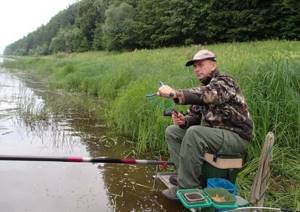
Feeding with peas
Fishing on currents involves some anticipation up to the point of direct fishing. In other words, the peas take a fair amount of time before they reach the bottom, and this fact must be taken into account. And finally, if you want to feed over very long distances (although this happens extremely rarely). Mix peas with soil. Then form the same small balls from the resulting mass as you usually would from any other bait. The material is now ready to be cast.
In strong currents it is difficult to overestimate the transport role of balls. Only they will help the bait get to the place on the bottom that is your goal. Please note: the faster the ball falls apart, the better for the business. It is logical that heavy grades of clay are undesirable (they are more appropriate if your goal is long-term attachment of fish, although, again, almost no one is interested in this now). Light loams are optimal because they erode quickly. And don’t worry about the bait at the bottom, the peas themselves will find “random” depressions, from where they will not be washed out even by a strong bottom current.
There is good practice for feeding during the current (believe me, it is very effective!). Mix the soil, peas with each other and add steamed wheat; Next, mix in loose, damp bait. This formula is general, suitable for all occasions - it means biting a wide variety of fish. But if your goal is exclusively large specimens, you don’t need to use anything else except peas and soil.
What kind of fish can be caught with peas?
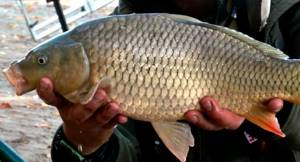
Almost all cyprinids prefer peas, such as:
- Ide . This fish bites on peas almost the whole summer, starting from May and until the beginning of September, when the water level in reservoirs is most optimal. The ide is a cautious and cunning fish that prefers to be in holes or near shelters, which can be trees fallen into the water. Quite often, weighty specimens are found within such places. The ide is most active in cloudy, rainy weather.
- Carp . Chickpeas are a type of pea and carp simply adores them. Chickpea seeds are larger and more flexible. Very often, various flavorings are added to chickpeas. The carp bites most actively in the spring, as well as at the beginning of summer. Larger individuals choose quiet areas of the water area, where there are thickets of aquatic vegetation and a lot of snags.
- Bream . This fish prefers regular peas prepared by steaming rather than boiling. During the process of steaming the nozzle, aromatic substances are added to the peas, such as: anise; honey; cake; vanillin.
- Carp . Starting from the second half of summer, carp begin to be actively caught on peas. This period can last until the end of autumn. Carp can be caught using peas both with a regular float rod and with a feeder. At the same time, carp may prefer canned peas, although this bait attracts a lot of “trifles”, and it does not hold well on the hook.
How to prepare peas for fishing and attach them to a hook? My fishing.
Bait storage
It is not enough to know how to properly prepare peas for fishing; you also need to remember how to store them.
Of course, if the entire fishing process lasts only a couple of hours and the entire mixture is consumed during this time, then such knowledge will not need to be applied, but if we are talking about long-term fishing, then such knowledge will need to be applied in practice.
So, in a couple of days, pea bait can deteriorate if stored incorrectly.
To extend the life of such a nozzle, it should be stored in a damp fabric bag, or even better, tie the bag to a branch and place it in water.
Advantages of peas and its disadvantages
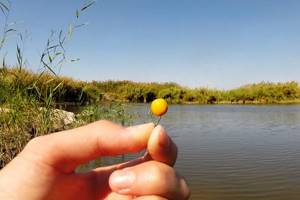
Using peas as a hook bait has a number of advantages:
- This is an all-season attachment. As a rule, peas are a favorite treat for many types of fish. At the same time, they do not refuse it at any time of the year.
- Easy to prepare. Preparing peas is quite simple, and every fisherman can choose the best option for himself. If during the cooking process the peas were overcooked and boiled, then you should not despair: such peas can be used in the recipe for bait.
- Cheapness. If you compare the cost of peas with the cost of purchased bait mixtures, you get a fairly cheap homemade bait. If you buy 1 kg of peas, it will last for a long time.
- Using conventional gear. Using peas does not require the use of any special gear; it is enough to arm yourself with a regular float rod or bottom tackle.
- Opportunity to catch big fish. As a rule, large individuals are more interested in peas. The fact is that “trifles” will not covet peas, since they are large in size, but individuals weighing up to 1 kg will definitely be interested in this attachment.
Disadvantages of using peas
The disadvantages, although few, exist. For example:
- Time spent on preparation.
- The need for preliminary feeding.
- Difficulty getting hooked.
Buying peas for fishing - nuances and recommendations
It should be noted that preparing peas for fishing is fundamentally different from preparing pea porridge. The task is this: you need to cook the grains so that they confidently stay on the hook (that is, they are dense enough for this), but at the same time they are well cooked. In general, if you know certain nuances, this task is not so difficult.
The most significant point is which peas are best for fishing and why. The fact is that varieties with wrinkled skin are ideal, but they are not so easy to find on sale today. Yes, before, there were no problems. Now search! However, it is advisable to comply with this condition, since wrinkled peas do not burst during cooking, and it is quite easy to monitor the degree of their readiness (and “catch” the moment of the end of cooking) without much stress.
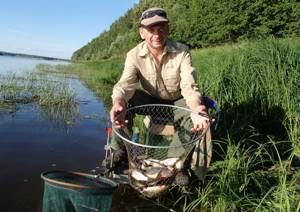
Pea bait for a variety of fish
And another reason why wrinkled varieties are preferable. Compared to smooth skin, wrinkled peas are often much larger. Therefore, it will attract large fish, not small ones.
Reality dictates its requirements: what is available for sale today is not exactly what we would like. At poultry markets and various feed warehouses, mainly pea varieties with smooth skin are offered. But don’t yawn here either; if possible, choose the largest available raw material. As for the quantity, 2-3 buckets will be enough for the season (after all, the volume of peas increases several times during cooking, the consumption during each cooking is small).
Which peas should you choose for fishing?
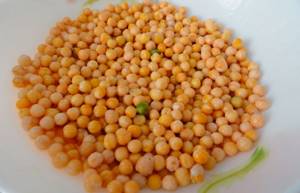
Peas can be selected by size and used to catch any size fish. Naturally, the larger the bait, the larger the fish will bite.
When choosing peas for fishing, you should pay attention to:
- The product must be fresh, without the presence of bugs. In addition, this will indicate the quality of the peas.
- The peas should be in their shells. Shelled or shelled peas are not suitable. The best option is when the pea seeds look shriveled. As a rule, their husks do not burst.
- The grains must be whole. You shouldn’t even try to put pea halves on a hook, especially since they won’t stick.
Secrets of a successful catch: preparing peas for fishing
Currently, fishing is not only a banal means for catching animals in a fishing spot. It has become a kind of ritual for every second man, allowing him to forget all everyday worries and sit peacefully with a fishing rod in his hands.
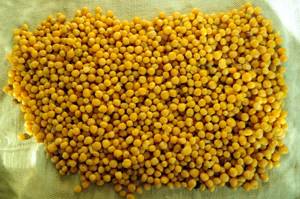
But in order for this action to also bring a positive result in the form of a catch, it is necessary to choose the right bait for the fish. One of the simplest and most accessible attachments can be the most common peas.
However, during preparation you should take into account some nuances that can significantly affect the quality of your future bait.
Proper cooking of peas
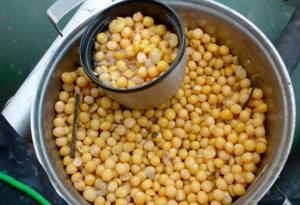
The prepared bait should not lose its marketable appearance and, especially, its shell. If you press lightly on the pea, it should not fall apart. It will be great if the peas turn out to be plastic and can slightly change their shape. When the seeds are soaked, you need to take a lot of water. The volume of water, relative to the volume of grains, should be about 5 times larger. If you add soda to the water, the soaking process will speed up. To do this, take 1 teaspoon of baking soda per 1 liter of water. At the same time, you need to look at how hard the pea grains are. Salt is not used. Just before the cooking process, the water and soda must be drained and replaced with plain water, otherwise the peas will boil.
During the cooking process, vegetable oil or milk is added to the peas, which makes the bait more catchable. If foam appears during the cooking process, it must be skimmed off. As a rule, peas should not be stirred as this may damage the integrity of the skin.
If you use a pressure cooker to cook peas, the cooking process can be shortened by 1 hour. To prevent the skin from separating from the grains during the boiling process, pea seeds can be placed in a fabric or gauze bag. Each variety of peas is cooked for a certain time, which is established experimentally.
The use of young or canned peas does not require any additional manipulations.
How to cook peas for fishing from Mikhalych
Peas as a nozzle
Peas, as bait on a hook, are used only canned or young, unshelled directly from the bush. Durum varieties must undergo pre-cooking before they can be planted. At home, you can quickly cook peas in a slow cooker without soaking. Large peas with a whole shell are used as a nozzle. Half-cut, chopped, suitable for cooking puree, grinding, flour.
Bait and bait are prepared from split peas. Such grains can be stored for a long time without losing their properties. Pea flour with semolina is excellent for making mastyrka. In addition, recipes for preparing various mastyrkas include barley and corn. Some types of boilies are also prepared using pea flour or cereal. Boilies with peas are the best type of vegetable bait.
Use a pea attachment:
- for carp;
- for bream;
- for crucian carp;
- roach with rudd;
- predators - ide, chub.
The bait gives good results on the river in winter. You just need to know how to properly cook, steam, and how to store such a wonderful bait and bait.
Fermented or sour peas, in the absence of a bite on all known baits, sometimes give positive results, allowing the fisherman not to be left without prey. Fermentation recipe, equipment, how to soak, how to plant, how to preserve
Choosing cereals
Whole unshelled peas are not easy to find in the store. In a department store you may find chickpeas, our larger cousin. However, in terms of cheapness, it is better to look for this product in pet food stores. It is better to stock up in large quantities at once, for example, a bag for a year. This amount is enough for many fishing trips. Peas are perfectly stored and do not lose their properties. It’s just that the older the grain, the longer it will have to be cooked. Steaming in boiling water only works with relatively young grain.
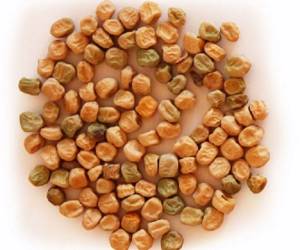
Whole pea grains can also be found on the market. It is better to choose wrinkled peas. Cook it longer. But it does not boil over, and during the cooking process it turns into good whole peas with intact skin, which is what is required for fishing. The seed is available in green, white or orange. For bait, we take white, orange, wrinkled whole peas or large chickpeas (this is even better for large fish - the diameter of the finished grain is 6-8 mm, and for a regular one it is 4-6 mm).

Soaking
Before you cook peas for bream fishing, you need to soak them. The soaking process is required. If you do not do this and cook immediately, the structure of the grain will be disrupted, the skin will burst, and the peas will fall apart. And it will take several hours to cook unsoaked peas. After soaking, the cooking process takes from half an hour to an hour and a half, depending on the age of the seeds.
To soak our future bait, we thoroughly rinse the seed in water and place it in a container with a third of its volume. It could be a can, a bottle, or anything. An approximate calculation is a liter of finished bait (for one rod). This is enough for baiting and adding to bait. When soaked, the peas, taking in water, increase in volume by about 3 times. Thus, to get a liter jar of finished bait, for soaking we take 1/3 of the total volume of seeds and fill it with water until full.
You need to insist for about 12 hours or more, at a temperature no higher than room temperature. In hot weather, peas may begin to sour. Therefore, in the warm season, it is better to put it in the refrigerator for soaking. After about 8-12 hours, the seeds will absorb water, swell and fill the entire volume. You can pour the grain for soaking into plastic bottles and store it in this form in the refrigerator for weeks. This is convenient - if necessary, we take an already soaked product for cooking. This way you can reduce the cooking time.
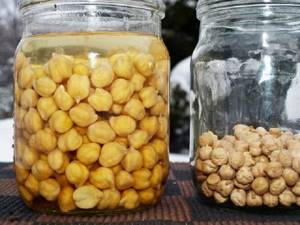
Cooking
Next, the most important thing is how to properly cook peas for bream fishing. Pour our semi-finished product from the jar into the pan, along with some water. Add water two fingers above the grain (more is possible) and put it on fire. To catch crucian carp at this stage, you can throw a clove of garlic into the pan. However, this aroma does not always affect bream, mostly in cold water. For bream, it is better to add a couple of tablespoons of sugar and a pinch of salt to the pan. The pea aroma itself is a great attractor for bream and carp.
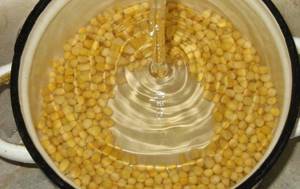
Set the heat to medium, bring to a boil and cook until done. Whole seeds are covered with a thin film, which should not be damaged during the cooking process. Ready peas are pureed inside. The bait is held on the hook by this dense outer layer. The main task when cooking is to ensure that the middle is boiled, and the outer shell remains strong enough and does not fall apart or burst. Stir gently during the cooking process - under no circumstances allow it to burn. And the flip side is that you should not allow changes in the temperature and intensity of boiling, or reduce the heat. As we put it at first, we keep it until the end of the process. Cooking requires attention, it can take up to an hour and a half, but usually from 40 minutes to an hour. We taste readiness with our fingers. The finished pea is whole. But when pressed, it flattens, squeezing out the soft inner part.
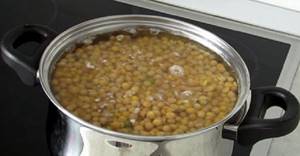
When the bait is ready, carefully drain the water and wait a while for it to cool. You can put it on a cloth and dry it a little. You cannot dry it for a long time - the bait will begin to release water and lose its properties. That's all - the best vegetable bait for bream and other large fish of the carp family is ready. We put it in a bag, a jar with a lid and go fishing. We use a small part as a bait, the rest is added to the bait for bream as a feed fraction. After soaking, young peas can not be boiled, but steamed in a thermos, like wheat, or in a saucepan of boiling water, wrapped in a towel.
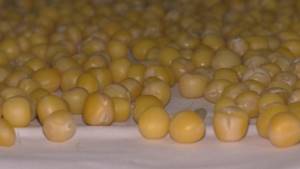
Cooking methods
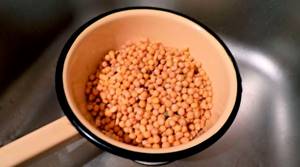
There are many ways to prepare peas for fishing, but you should pay attention to the most famous ones. For example:
Method one
- The peas are placed in a colander and washed with clean tap water.
- The washed peas are placed in a saucepan, filled with water and left for up to a day to swell.
- After this, the bait is placed on low heat and cooked until tender. In order not to miss it, it is better to check it from time to time for readiness, using a thin needle for this. The product should be soft, but not fall apart.
Method two
- Prepared, already soaked peas are poured with water, put on fire and brought to a boil.
- As soon as the grains boil, turn off the fire and cool the seeds.
- After this, the bait is placed in a water bath and the fire is turned on.
- The peas are cooked this way for about 2 hours.
Method three
- Prepared swollen pea seeds are placed in a fabric bag or stocking and tied.
- This bag of peas is placed in a pan so that it does not reach the bottom and filled with water.
- Place the pan on low heat and cover with a lid.
- In this way, peas are cooked for a certain time until cooked.
Once ready, you need to give the pea grains time to cool. Then they begin to select those that are suitable for catching fish. They are placed on a fabric base and dried.
If you manage to purchase wrinkled peas for fishing, then you do not need to soak them before cooking. These peas are cooked for about 3 hours over low heat. It is perfect for catching large fish using a bottom fishing rod.
The right peas for large bream and other peaceful fish | 1080p | FishingVideoUkraine
Bait recipes
If you are going fishing to a pond where crucian carp lives, then without good complementary food you are unlikely to be able to catch anything. Therefore, it is necessary to prepare in advance and cook the right complementary foods. The main thing here is that the porridge is very aromatic and noticeable to fish living at the bottom of reservoirs.
Recipe 1
Anglers very often use mastyrka as complementary food. This is a special porridge that requires a certain amount of ingredients, including peas. Moreover, each fisherman may have his own cooking recipe and differ from another. It all depends on the reservoir where the fish are caught, what kind of fish lives there, and what they were fed with before.
Let's consider one of these simple bait recipes.
So, you will need:
- peas;
- semolina;
- pearl barley;
- corn;
- wheat;
- flavorings – vanilla, hemp and others.
Procedure:
- Take the peas and wash them thoroughly. Fill it with water and leave it for 10-15 hours.
- After the time has passed, drain the water. Pour the soaked peas into a saucepan and add water in a ratio of 1 to 2.
- Initially, it is advisable to take ground peas or halves, because after cooking, whole peas will have to be ground.
- Place the pan on the stove, bring the water to a boil, reduce the heat and cook, stirring occasionally with a spoon.
- As soon as the complementary foods resemble liquid pea porridge, you need to add the following ingredients: pre-boiled pearl barley, boiled corn, preferably young, pre-soaked wheat.
- Mix dry semolina with vanilla from a bag, hemp or other flavoring of your choice.
- After all the ingredients have been added, mix everything and wait for it to boil.
- After boiling, add semolina mixed with flavorings.
- You need to add semolina until you get a very thick consistency. And don't forget to stir all the time. The mixture should be such that it becomes very difficult to mix.
- Once the porridge becomes very viscous, remove the pan from the heat and leave it until it cools completely.
- Once the mastyrka has completely cooled, you can roll it into balls of the required size.
When preparing complementary foods, do not forget to stir them constantly. The finished mastyrka balls should be of such a size that they can dissolve in water for a long time, spreading the aroma and all the particles of the components.
Recipe 2
For this recipe you will need:
- Peas. Yellow is the best color here.
- Wheat flour.
- Balls from bags.
- Threads.
Procedure:
- You need to cook porridge from washed yellow peas. To do this, take water and peas in a ratio of 2 to 1.
- Pea porridge should be cooked for at least an hour. It is necessary that all the peas are completely boiled.
- If there is any water left after cooking, it must be drained.
- Now add flour to the pea porridge in a ratio of 2 to 1. If the consistency is not very dense, then you can add more flour and mix everything thoroughly.
- Then you can add flavorings. Which ones you need will depend on the taste preferences of your future catch.
- Add water in such an amount that your complementary foods are as thick as sour cream with a high fat content.
- Now put the finished mixture into a bag. To be safe, you can use 2 at once. Tie the bag tightly and place it in a pan with cold water. The bait needs to cook for about 30 minutes.
- 20-30 minutes after the water boils, turn off the fire and leave the bag of pea food to sit for a while in the same container of water.
As a result, you will get a dense pea porridge, which can be cut into small pieces and used as bait on a hook and bait for fish. Also, the bait in this form can be used together with a feeder.
Recipe 3
You will need:
- pea flour;
- wheat flour;
- small plastic bags;
- threads
Procedure:
- Mix pea and wheat flour. For this recipe you need to use both flours in equal proportions.
- At this stage you can add the necessary flavorings.
- Now we add water and bring the consistency of the complementary food to a state where it is not too thick, as in the previous version, but does not flow off the spoon.
- Place the prepared mixture into bags and tie them tightly with thread.
- Place in a saucepan with cold water and cook for 30 minutes.
All other steps will be similar to the previous recipe. In this option, only the procedure is changed; with it, of course, the entire cooking process is significantly shortened.
Recipe 4
The bait prepared according to this recipe is perfect for fishing for silver carp.
You will need:
- peas;
- baking soda;
- semolina;
- honey.
Procedure:
- Take a large saucepan and pour at least 4 liters of water into it. Place it on the stove and wait until the water gets very hot.”
- Without waiting for it to boil, pour 1 kg of washed peas into the water.
- As soon as the peas begin to boil, you will need to add 2 tbsp. l. baking soda. At the same time, do not forget that the peas must be thoroughly mixed both before and after boiling.
- Pea porridge should be cooked over low heat for at least 3 hours. All peas must be thoroughly boiled.
- After the desired consistency is obtained, the pan must be removed from the stove. Next you need to drain the pea broth. To do this, place the colander on another convenient container. Whatever remains in the colander will no longer be useful. But what is poured into the container during the process will need to be used further.
- The container with the broth must be placed on the stove and brought to a boil.
- Now, while it is boiling, add semolina gradually and in small portions to this liquid. You will need about 2 kg.
- When you add semolina, do not forget to constantly stir everything so that there are no lumps. The result should be a porridge that will be difficult to stir.
- The semolina should swell completely and the porridge should thicken. As soon as the porridge starts to boil, remove the pan from the stove.
- The container with the pan can be immediately removed onto a wooden cutting board.
- As soon as you remove the porridge from the stove, semolina must be continuously added and mixed. Add semolina until it is no longer possible to mix with a spoon.
- Place the resulting porridge on the board. Sprinkle the board with semolina first.
- Mix the porridge with semolina. Stir until the food stops sticking to your hands. In this case, the mass should not be cold and should cool down after you have mixed everything.
- Take 1 tbsp. l. honey and melt in a water bath.
- Pea feeding should be divided into several small parts and honey should be added to each of them and everything should be mixed thoroughly again.
Ready-made bait will be useful to you not only on your upcoming fishing trip.
This amount of porridge will be enough for several more trips. Therefore, such a preparation can be put into bags and frozen for a long time.
How to steam peas for fishing
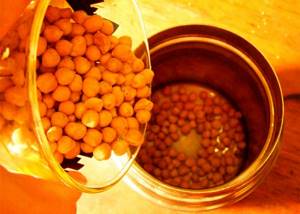
Instead of the labor-intensive cooking process, many anglers use the method of steaming grains. This process has a number of advantages. Firstly, you don’t need to stand at the stove and control the cooking process, and secondly, the seeds will never be overcooked.
- To do this, you need to take a large thermos, about 2 liters, and pour 2 cups of peas into it.
- It is advisable to add 1 teaspoon of soda here.
- Boiling water is poured into the thermos, after which the peas are left for 8 hours.
As a rule, fishermen do this: they steam the peas in advance, in the evening. Upon arrival for fishing, the bait will be prepared. This method saves a lot of precious time.
When peas are steamed, you can add the following flavoring to the thermos:
- anise;
- hemp oil;
- sunflower oil.
Steaming in a thermos
If the pea decoction takes a lot of time, you can use another method of preparing it - steaming it in a thermos.
Namely:
- pour a glass of beans into a large thermos;
- add 1 tsp. soda;
- pour boiling water in the amount of one liter;
- leave for 10 hours.
This method guarantees the integrity of the peas. It is advisable to keep the bait in gauze or other fabric packaging.
Method of placing peas on a hook
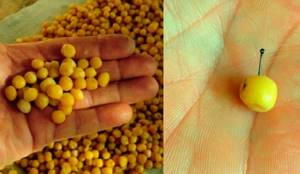
Peas are such a bait that if you put them on the hook incorrectly, they will immediately fly off. As far as we know, each pea consists of 2 parts (halves). The hook must penetrate both halves, then the pea will be securely held on the hook. If the hook is inserted between two halves or at an angle. It will either fly off immediately or after a while. Depending on the size of the hook, plant one or several peas at a time.
At the same time, it is better to leave the hook tip open so that an effective hook can be made. When fishing for carp, a different type of fishing gear is used. At the same time, peas are strung on thin hair in the form of a garland.
Favorite carp bait “Universal pea” (DR)
How to plant grains?
To prevent the delicate pea bait from flying off the hook, the grains must be planted correctly.
To do this, the sharp part of the hook is stuck into the “eye” of the pea, which has a lighter color. Then the sting is passed through the two halves of the bean so that they do not fall apart. Sometimes two or three peas are planted.
When catching picky fish, the hook tip is threaded through. To hunt wary fish, the tip is hidden in the grain.
To catch carp, the hook is hidden only a few millimeters. Only its tip should be hidden in the bait.
The vegetable can also be strung on hair cords. To do this, peas are pierced with a needle in the central part and several pieces are put on in the form of a garland. This bait most often attracts carp.
